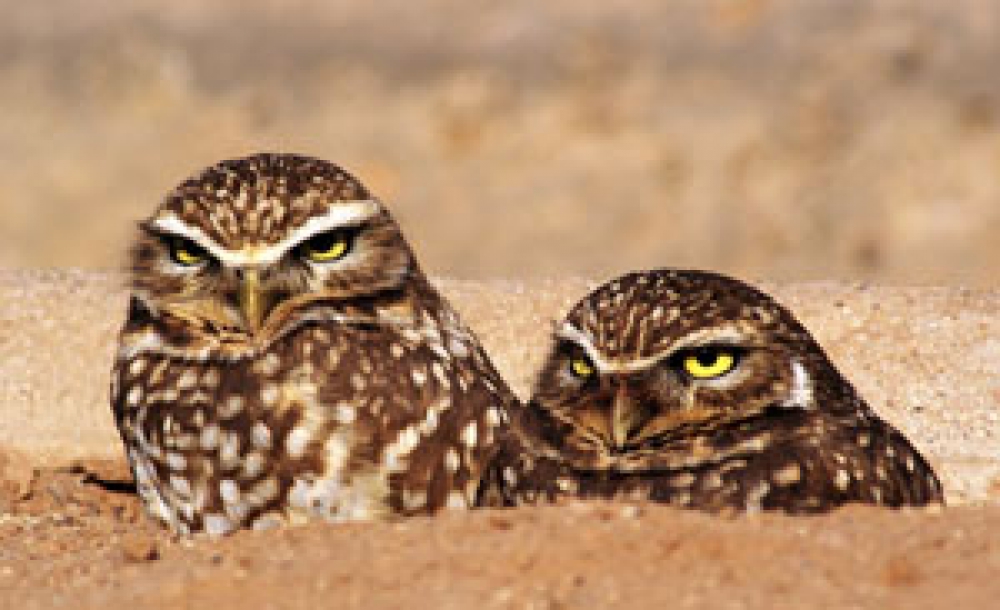Common name: Burrowing Owl
Latin name: Athene cunicularia
Status under SARA: Endangered, 2006 COSEWIC assessment: Endangered
Range: Alberta, Saskatchewan, Manitoba
Life Span: three to four years
Size: 23-28 cm tall; weighs 125-185 g
Population Estimate: Fewer than 1,000 pairs in Canada
The Facts
Burrowing Owls often stand upright on their long thin legs so they can see farther out over the flat prairie.
Often, the male will stand watch outside the burrow while the female and her young are underground. If an intruder comes near, the male sounds an alarm call and then tries to lure the intruder away from the nest with a series of short flights. If the intruder continues, the young birds go to the back of the burrow and make a hissing noise that sounds like a rattlesnake.
They leave for their wintering areas in the southeastern United States and Mexico in September, and return to Canada in April.
Grasshoppers and beetles are the favourite foods of the Burrowing Owl. They also eat a few mice, voles, ground squirrels, toads, small birds, and carrion.
Females lay six to twelve white eggs and incubate them for about four weeks. When the nest gets too crowded (after about two weeks), the young move to the entrance of the nest where they stand waiting for the adults to bring them food. About seven to eight weeks after hatching, the young will start to feed themselves.
After the young are active above ground, they may move to other burrows near the burrow in which they were born.
The Story
Burrowing Owls look like little owls on stilts. They are 23-28 cm tall standing on long thin legs. The Burrowing Owl is unlike most owls in many ways: it lives in burrows in the ground, is active during the day, the female is smaller than the male, and its favourite foods are insects.
Burrowing Owls were common summer residents in the southern regions of the prairie provinces and BC until the mid-1900s when modern agriculture practices began. Cultivation of the land for agriculture has severely reduced Burrowing Owl habitat over the years. By 1979, Burrowing Owls were extirpated from BC. Burrowing Owl populations in the prairie provinces continue to decline. Today, it is thought fewer than 1,000 pairs remain in Alberta and Saskatchewan, and on rare occasions in southwestern Manitoba. Occasionally, the owls winter in coastal British Columbia and are seen in Ontario and Quebec during spring.
Burrowing Owls require open areas with low ground cover, existing burrows, and abundant food. They rely on holes in the ground made by ground squirrels, badgers, and foxes in which they make their nests. Unfortunately, some farmers regard these animals as pests and kill them. With declining populations of these mammals, Burrowing Owls are unable to find suitable nesting sites. Furthermore, ground squirrels and foxes are often killed with poison and, when Burrowing Owls feed on their carcasses, they too are poisoned.
Another threat Burrowing Owls face is “Carbofuron,” a pesticide used to kill grasshoppers in farm fields. When Carbofuran is applied in fields and Burrowing Owls eat the poisoned grasshoppers, the insecticide accumulates in the owls’ bodies. Where Carbofuran is used within 50 m of burrows, the affected owls produce 54 percent fewer young than normal.
While many Burrowing Owls migrate to the southern US and Mexico for the winter, researchers have been trying to find out why only half of adult Burrowing Owls come back to their northern breeding grounds each spring, and why a mere six per cent of young owls return to breed in Canada the year after they are born.
What is Being Done
Burrowing Owls are protected in all provinces where they are found – BC, Alberta, Saskatchewan, and Manitoba.
“Operation Burrowing Owl” was established in Saskatchewan in 1987 to encourage landowners to protect the Burrowing Owls’ nesting habitat. By 1994, 534 landowners in Saskatchewan had committed themselves to protecting owl habitats. In Alberta, the program has expanded to include protection for other endangered species, and is called “Operation Grassland Community”. By 1994, about 260 landowners in Alberta had committed to protecting habitats around owl nesting sites, amounting to over 22,000 ha.
In 1992, six Burrowing Owl pairs were reintroduced to the southern interior of British Columbia. As of 1995, an estimated five to ten pairs of Burrowing Owls were living in BC.
In 1994, the Operation Burrowing Owl newsletter was translated into Spanish for Mexican distribution in the hope that protection will be offered to the birds in their wintering areas.
In 1996, a decision was made by the federal government to slowly phase out some of the uses of the insecticide Carbofuran.
In addition, a national Burrowing Owl recovery team, working through Recovery of Nationally Endangered Wildlife (RENEW), approved a recovery plan in 1995 and updated the plan in 2002. The end goal of the plan is to increase Burrowing Owl populations in Canada to levels where they become self-sustaining.
What You Can Do
- Learn more about the Burrowing Owl and its habitat and share this information with your family, friends, and community.
- Support groups and individuals who are working to save the Burrowing Owl.
- Encourage farmers and other landowners not to disturb areas in which Burrowing Owls live. Encourage landowners to use alternatives to pesticides or lower doses of these chemicals.
Read the full article at Nature Canada
